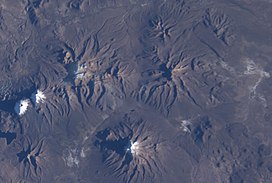| Laram Q'awa | |
|---|---|

Parinacota,
K'isi K'isini,
Pomerape, Laram Q'awa,
Patilla Pata and
Sajama (l-r) as seen from NASA space shuttle | |
| Highest point | |
| Elevation | 5,182 m (17,001 ft) [1] |
| Coordinates | 18°01′09″S 69°08′33″W / 18.01917°S 69.14250°W |
| Geography | |
| Location | Bolivia |
| Parent range | Andes |

Laram Q'awa ( Aymara larama blue, q'awa little river, ditch, crevice, fissure, gap in the earth, [2] [3] "blue brook" or "blue ravine", Hispanicized spellings Laram Khaua, Larancagua) is a 5,182-metre-high (17,001 ft) mountain in the Andes. According to the Bolivian IGM map 1:50,000 'Nevados Payachata Hoja 5739-I' it is situated on Bolivian terrain in the La Paz Department, Pacajes Province ( Charaña Municipality), at the border with Chile. It lies north-west of the mountains Kunturiri, Phaq'u Q'awa and another mountain on the border named Laram Q'awa (Laram Khaua). One of three different rivers of this area called Kunturiri (Condoriri) originates north-east of the mountain near Phaq'u Q'awa. It flows in a bow along the northern slopes of Laram Q'awa towards Chile. [1] [4]
See also
References
- ^ a b BIGM map 1:50,000 Nevados Payachata Hoja 5739-I
- ^ Radio San Gabriel, "Instituto Radiofonico de Promoción Aymara" (IRPA) 1993, Republicado por Instituto de las Lenguas y Literaturas Andinas-Amazónicas (ILLLA-A) 2011, Transcripción del Vocabulario de la Lengua Aymara, P. Ludovico Bertonio 1612 (Spanish-Aymara-Aymara-Spanish dictionary)
- ^ "Diccionario Bilingüe, Castellano - Aymara, Para: Tercera Edición". Félix Layme Pairumani. Archived from the original on September 2, 2013. Retrieved September 14, 2014.
- ^ "Charaña". Archived from the original on November 7, 2014. Retrieved September 14, 2014. (unnamed, north-west of Phaq'u Q'awa (Paco Khau))
